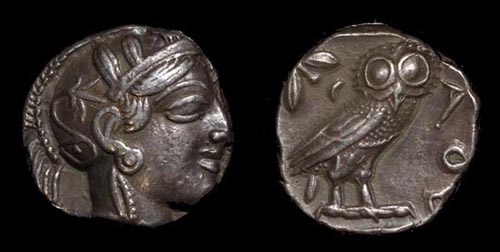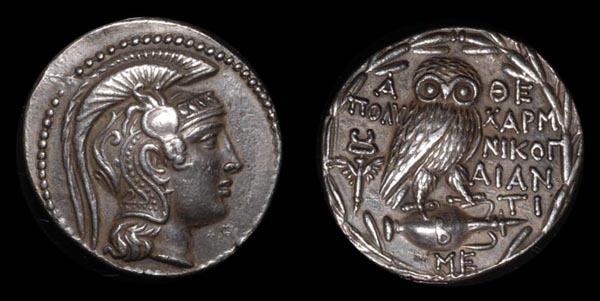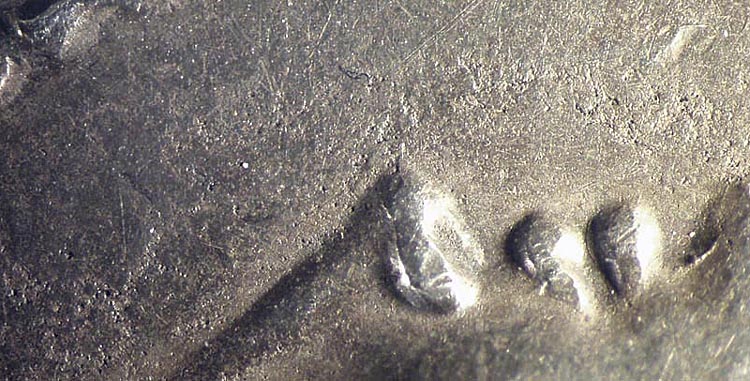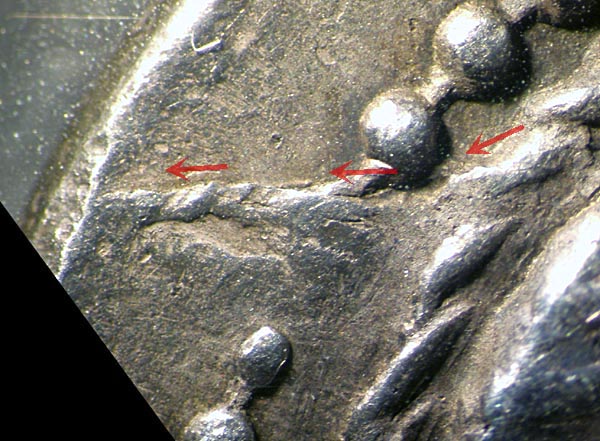In ancient times, the Athenian
owl coin was perhaps the first standardized currency to be used
over
a wide geographical area, and circulated for over 200 years. Today,
they are a symbol of the
artistic beauty found on many ancient Greek coins. The following is a
study
of two owls, the first from the the
early period of Greek coinage around 400 BC and the second from around
160BC. Both are silver tetradrachms, a standard unit of currency.
An Early Period Athens Owl
An Early Period Athens Owl

Most Greek coins were hand
struck using dies and evidence of this striking is easily seen on
this coin's obverse
and reverse. The first image below shows the lower part of
the owl's
breast, legs, and tail, all of which are outlined with a low rise ridge
of metal produced when the coin was struck. The ridges are caused by
plastic flow of the metal under extreme pressure. The red arrows
point to areas where there appear to two parallel ridges, which
might indicate that the coin was struck twice. Small
edge cracks are also seen near the owls feet. Weight 17.14g.

On the obverse, evidence of
plastic flow is seen in a halo of fine tendrils that surround the owl's
head. The halo is most prominent on the left
side where it streatches as far as the fig leaf feature on
the far left between the two arrows.

There is also ample evidence
that suggests the
metal is quite old. The coin is thick and the rim has a rather lumpy
metal appearance. Parts of
the rim have what looks like a compressed crystalline structure made of
many find nodules pressed flat by the striking. The
nodules probably formed as the metal cooled and solidified before it
was struck. Red arrows
point to the nodule areas.

Evidence of metal aging can be
seen in the reverse field from
a series of deep microscopic fissures. These fissures follow along the
lines of possible stress cracks in the metal where corrosive forces can
easily attack into the metal. Such corrosion likely occurs over
a long period of time. The red arrows run in the direction of the
stress
crack.

A Later Period Athens Owl
Late period tetradrachms were
struck on larger but thinner
planchets but retain the superbly high relief features seen on the
earlier owls. The facial portraits on
some of these coins are so beautiful they almost look
like photographic images of real people. The coin's weight is typical
at
16.91g.

The coin has flow marks that
are typical
of striking,. These are easily seen on the obverse along the dots that
run along the
coin's outer rim. Again, it appears that the coin may have been struck
twice.

Micro pitting is seen along
probable stress boundaries in the field in a region roughly outlining
the face
of the portrait. These pits tend to form along lines, which are
particularly clear on the
left.

A blow-up of the left hand region in the previous image showing the pits traveling in lines.

There is also a crack that runs from the rim almost to the chin of the portrait.

One of the most interesting
features is perhaps a die crack at about 10 o'clock and two missing
dots along the rim. The crack runs in the direction of the red arrows
in the image.
The surface of the metal below the arrows is slightly
raisesd relative to the area above the red arrows, typical of a die
crack.

Related Links
An excellent page on modern owl forgeries and identification. http://rg.ancients.info/owls/forgeries.html